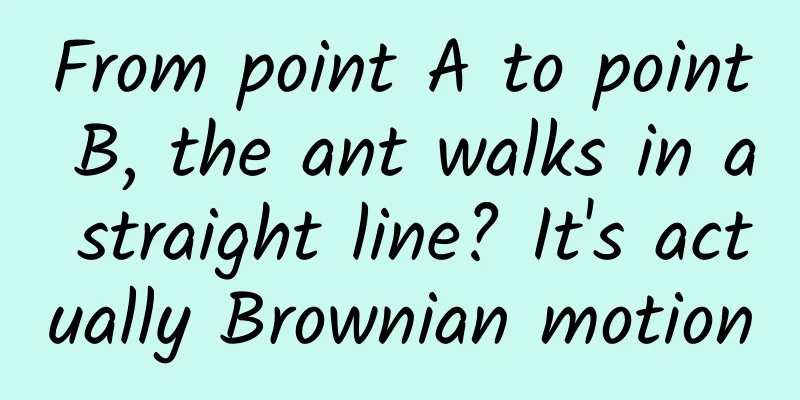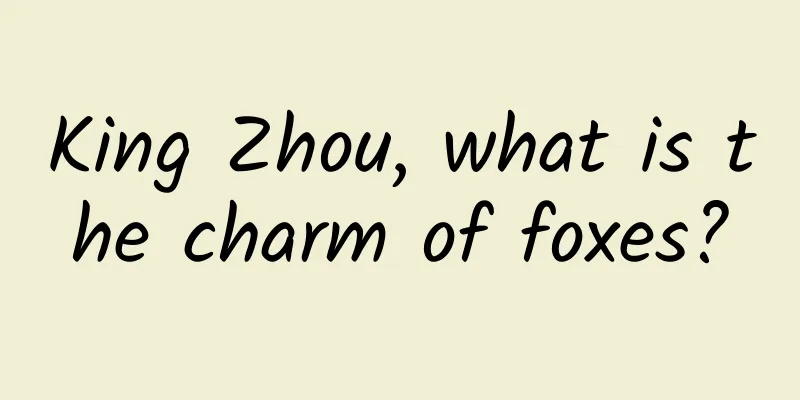From point A to point B, the ant walks in a straight line? It's actually Brownian motion

|
Produced by: Science Popularization China Author: Su Chengyu (popular science creator) Producer: China Science Expo Editor's note: In order to decode the latest mysteries of life science, the China Science Popularization Frontier Science Project has launched a series of articles called "New Knowledge of Life" to interpret life phenomena and reveal biological mysteries from a unique perspective. Let us delve into the world of life and explore infinite possibilities. Ants have always been a frequent visitor in math problems, because they always need to walk from point A to point B, and then calculate their shortest walking distance. They can walk on a cube, or two cubes, or even a cylinder... In any case, the premise of the solution is based on the premise that ants walk in a straight line, but do ants really walk in a straight line in reality? Before answering this question, we have to move the topic to the desert. The desert is one of the easiest places to get lost. There are few visual clues to navigate besides the sand and the sun. Much of the terrain looks similar, which makes it difficult to find your way around. Not to mention the strong winds in the desert, the blowing sand will not only change the terrain but also block the view. The wind and sand may also cover the traces of walking, making it difficult for people to find the way back. But for the long-legged desert ants living on the vast salt plains of Tunisia, finding a way is a common thing. After all, if they can't find a way, they can't survive in the desert and would have been extinct long ago. They usually act alone and go out alone to find some insect carcasses as food. Sometimes the foraging distance can reach tens or even hundreds of meters. After finding the food, they bite it with their jaws and drag it to the nest. Long-legged desert ants dragging a spider's corpse (Image credit: Harald Wolf) So how do they find their way home? Harald Wolf began studying the navigation of desert ants in 2000, when he discovered that the ants’ paths home were rarely straight. The experiment recorded the walking paths of five desert ants as they approached a food source. The red circles indicate the locations of the food points. It can be seen that the paths of these ants are not straight lines. (Image source: Reference 1) Scientists have discovered that whether the desert ants are walking headfirst or dragging food backward, they will show a graffiti-like curved trajectory (see the picture below), with almost no pattern to it, except that when walking forward, the path lines look slightly smoother. Graffiti-style curved track (Image credit: Harald Wolf) According to the results of this article, desert ants can effectively combine visual and odor clues to locate food sources. This is just the initial experimental result. After 20 years of continuous research, Wolf found that the navigation ability of desert ants is very complex, not just simple visual and odor clues, but also path integration and solar navigation. Path integration is the main navigation method. We can think of this process as a kind of "ant GPS". How do scientists know this? They conducted an experiment to change the leg length of ants. They increased the leg length of some ants and installed "little stilts" to make them take bigger steps. For other ants, they reduced the leg length by cutting the legs shorter to make them take smaller steps. Then they laid sand on the experimental site and recorded the walking paths of the ants. Scientists observed and recorded the walking paths of the ants from the nest to the food point. The paths of ants were recorded using high-speed cameras. (Image credit: Harald Wolf) Desert ants with lengthened and shortened legs (Image source: Reference 4) Scientists calculated the total distance and direction of the ants' travel by recording their walking direction and number of steps. All the paths of the ants were synthesized to obtain the straight-line distance and direction of their return to the nest. They found that when the ants' step length was changed, the location of their return to the nest changed. This shows that ants rely on the number of steps and stride length to calculate the distance traveled. Wolfe testing in the desert (Image source: Reference 4) You can imagine a desert ant setting out from its nest to find food. It first walks 50 steps east, then 30 steps north, and finally 20 steps west to find food. Its path is like a zigzag. Now it wants to go home, and it will calculate a direct path home, which may be 30 steps south, then 30 steps west. This is also the direct reason why desert ants cannot walk in a straight line. The combination and interaction of multiple navigation mechanisms cause the ants to deviate from the straight line. In the latest research, scientists found that in some cases the paths of ants are not only not straight lines, but also tortuous and irregular, showing the characteristics of random walks, similar to Brownian motion. Experimental site (Image credit: Harald Wolf) They further measured changes in path angles by tracking and recording the paths that the ants took to find food and return to their nests. They divided the ants' paths into small segments, each about 50 centimeters long, and measured the angle changes between each segment. For example, if the ants first walked east and then walked north, the angle between the two directions was 90 degrees. The path of the ant from the starting point to the end point (Image source: Reference 2) Afterwards, scientists conducted a statistical analysis of all the angles and calculated the average and distribution of the angles. The results showed that these angles were evenly distributed between 0 and 360 degrees, indicating that the paths of desert ants are random, similar to Brownian motion. Of course, the Brownian motion characteristics of desert ants do not appear in all search actions, but mainly when they cannot find the target, they will start searching behavior. At this time, their walking paths show obvious Brownian motion characteristics. When approaching the target, that is, when approaching the nest and feeding point, the path of the desert ants will slowly become straight. In other words, as soon as the desert ants go out, they are almost all random Brownian motion, and only when they find food and are close to the door of their home will they slowly become straight. In 2019, French scientists were inspired by desert ants and designed a robot called AntBot that can navigate autonomously without GPS and find its way back to base. The robot weighs 2.3 kilograms, has six legs, and is able to move on rugged terrain. AntBot (Image source: sciencedaily) AntBot is equipped with an optical compass that senses polarized light from the sky. This compass can measure direction with an accuracy of 0.4 degrees in sunny or cloudy weather conditions. The robot is also equipped with an optical flow sensor to measure relative motion. This sensor calculates the distance traveled by observing changes in the texture of the ground. Similar to the path integration mechanism of ants, AntBot also counts its steps to accurately calculate how far it has walked. In the experiment, AntBot was able to randomly explore in a complex environment and return to its starting position accurately with an error of no more than 1 cm. Who would have thought that one day, robots would no longer need GPS to navigate, and all of this was inspired by the tiny desert ants. References: [1]Wolf H, Wehner R. Pinpointing food sources: olfactory and anemotactic orientation in desert ants, Cataglyphis fortisJ. Journal of Experimental Biology, 2000, 203(5): 857-868. [2] Wolf H, Baldy N, Pfeffer SE, et al. Geometrical multiscale tortuosity of desert ant walking trajectoriesJ. Journal of Experimental Biology, 2024, 227(10). [3] Pfeffer SE, Wahl VL, Wittlinger M. How to find home backwards? Locomotion and inter-leg coordination during rearward walking of Cataglyphis fortis desert antsJ. Journal of Experimental Biology, 2016, 219(14): 2110-2118. [4] Gadagkar R. How to Design Experiments in Animal Behavior: 5. How Do Ants Estimate the Distance Walked? J. Resonance, 2019, 24: 875-889. [5] CNRS. "The first walking robot that moves without GPS." ScienceDaily. ScienceDaily, 13 February 2019. [6] TechXplore. "The first walking robot that moves without GPS." 13 February 2019. |
<<: Fish that don't work hard will be punished by their leaders | Natural Trumpet
>>: Can I finally use the "magic drug" to lose weight? All your concerns are here
Recommend
Why can't opponents follow suit in the protracted battle that Liang Jun is leading LeTV Super TV to fight?
2017 has become a big year for the development of...
Community operation methodology: how to gather target users
In early 2015, communities began to become popula...
7000 words, predicting the new media operation trends in 2019
From 2016 to this year, it is the third year for ...
Can you drink water right after taking cough syrup? 99% of people do it wrong!
Recently, the comment section of a video about co...
Snowball Irish Thrush Stock Trading Training 2021 Course Video
Snowball Irish Thrush Stock Trading Training 2021...
Insomnia, hair loss, and possible extinction... It's really hard to be a giraffe!
This article was first published by Hunzhi (WeCha...
Do you know how to ask Handler questions at the elementary, intermediate and advanced levels?
Handler is a message processing mechanism in Andr...
China Automobile Dealers Association: China Automobile Retention Value Report for December 2021
In January 2022, the China Automobile Dealers Ass...
Falling asleep to music? Beware of earworms!
Many people have the habit of listening to music ...
One person infected can infect the whole family. If you have these symptoms, you need to see a doctor as soon as possible.
Recently, Jiangsu Province released the "Jia...
Can palm lines be used to diagnose high blood pressure? Will frequent use of antihypertensive drugs make blood vessels fragile? Don't believe these rumors
Hypertension is a common chronic disease and is k...
Can you keep the cute "jade rabbit" in the sea? I advise you to hold back!
⚠Calendar Girl Front Row Reminder⚠ This article i...
Analysis of customer acquisition from 0 to 1
Magical 2020, all the anxiety is generated on &qu...
Subway access to Alipay: NFC phones pass through gates directly
Starting today, all self-service ticket machines ...
Microsoft is working on Android Launcher
[[142899]] Microsoft is currently developing a la...
![[Special Topic] Why are WeChat red envelopes so popular? Here are some unknown facts behind it!](/upload/images/67ebee61b99a4.webp)








